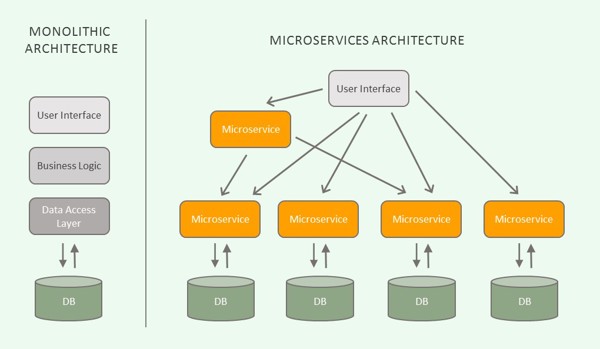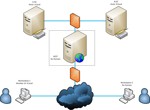
In the evolving world of software development, microservices architecture has become one of the most effective ways to design distributed systems. Java, being a widely adopted language in enterprise systems, is a natural fit for building scalable microservices applications. This article explores how to design distributed systems using Java microservices architecture, providing real-life examples, code snippets, and a comprehensive look at best practices.
Real-Life Example: Building an E-Commerce System with Microservices
Imagine you're building an e-commerce system that handles product catalogs, payments, orders, and shipping. Traditionally, this would be designed as a monolithic application. However, as the system grows in complexity, updating or scaling individual components becomes a challenge.
Using microservices, you can split these components into smaller, autonomous services:
- Product Service: Manages the product catalog.
- Order Service: Handles customer orders.
- Payment Service: Processes payments.
- Shipping Service: Tracks and manages shipments.
Each service operates independently, making the system easier to manage, scale, and update without impacting other services.
Designing a Java Microservices Architecture
A microservices architecture involves creating small, independent services that communicate over the network. Java, with frameworks like Spring Boot and Spring Cloud, simplifies the development of microservices.
Step 1: Break Down the Monolith
Let’s begin by breaking down a monolithic application into smaller microservices. Each service has its own responsibilities and can be developed, deployed, and scaled independently.
For example, let’s design two services:
- Product Service for managing products.
- Order Service for handling customer orders.
Here’s a simple code example for the Product Service using Spring Boot:
java
// ProductService.java
@RestController
@RequestMapping("/products")
public class ProductService {
private final List<Product> products = new ArrayList<>();
@GetMapping
public List<Product> getAllProducts() {
return products;
}
@PostMapping
public Product addProduct(@RequestBody Product product) {
products.add(product);
return product;
}
}
Explanation:
- The ProductService is a REST controller that exposes endpoints for fetching and adding products.
- Each microservice runs as an independent application and can be scaled as needed.
Real-World Analogy: Think of microservices like separate stores in a shopping mall. Each store (service) handles its own inventory and operations, but together, they form the entire shopping experience (the application).
Communication Between Microservices
In a microservices architecture, services need to communicate with each other. This is typically done using HTTP REST APIs or messaging systems like Kafka or RabbitMQ.
Example: Calling the Order Service from the Product Service
Let’s say the Order Service needs to communicate with the Product Service to check product availability before placing an order.
java
// OrderService.java
@RestController
@RequestMapping("/orders")
public class OrderService {
@Autowired
private RestTemplate restTemplate;
@PostMapping
public String placeOrder(@RequestBody Order order) {
String productServiceUrl = "http://localhost:8080/products/" + order.getProductId();
ResponseEntity<Product> productResponse = restTemplate.getForEntity(productServiceUrl, Product.class);
if (productResponse.getStatusCode() == HttpStatus.OK) {
// Process the order
return "Order placed successfully for product: " + productResponse.getBody().getName();
} else {
return "Product not available";
}
}
}
Explanation:
- RestTemplate is used to send an HTTP request from the Order Service to the Product Service to check if the product is available before placing an order.
Real-World Analogy: This is like a cashier (Order Service) checking inventory (Product Service) to ensure an item is in stock before completing a purchase.
Best Practices for Java Microservices Architecture
1. Single Responsibility Principle (SRP)
Each microservice should have a single, well-defined responsibility. This makes services easier to maintain, update, and scale. Avoid mixing different concerns in a single service.
2. API Gateway Pattern
An API Gateway serves as a single entry point for external clients to interact with your microservices. It handles authentication, request routing, rate limiting, and aggregating responses.
Example of API Gateway with Spring Cloud:
java
@SpringBootApplication
@EnableZuulProxy
public class ApiGatewayApplication {
public static void main(String[] args) {
SpringApplication.run(ApiGatewayApplication.class, args);
}
}
Real-World Analogy: Think of an API gateway like the front desk at a hotel. Guests interact with the front desk to access various services (room service, housekeeping), rather than contacting each service directly.
3. Decentralized Data Management
Each microservice should manage its own database. Avoid sharing databases between services. This allows each service to scale independently and reduces coupling.
Example:
- Product Service manages a product database (e.g., MySQL).
- Order Service manages an order database (e.g., PostgreSQL).
4. Service Discovery
When microservices run on multiple instances across distributed systems, they need to discover each other. Tools like Eureka or Consul allow services to register and discover other services dynamically.
5. Fault Tolerance and Circuit Breakers
In a distributed system, services may fail or become temporarily unavailable. Use circuit breakers (e.g., with Hystrix) to handle failures gracefully and prevent cascading failures.
Example with Hystrix:
java
@HystrixCommand(fallbackMethod = "fallbackMethod")
public String callProductService() {
// Call Product Service
return restTemplate.getForObject("http://product-service/products", String.class);
}
public String fallbackMethod() {
return "Product service is currently unavailable. Please try again later.";
}
Explanation:
- If the Product Service fails, the circuit breaker triggers the
fallbackMethod()to handle the failure gracefully.
6. Centralized Configuration
Managing configurations for multiple microservices can be challenging. Use a centralized configuration service like Spring Cloud Config to manage configurations across all services from a central location.
7. Monitoring and Logging
Monitor the health and performance of your microservices using tools like Prometheus and Grafana. Use centralized logging with tools like ELK Stack (Elasticsearch, Logstash, Kibana) to track logs from multiple services.
8. Security
Ensure that each service is secured, especially when communicating over a network. Use OAuth2 or JWT (JSON Web Tokens) for authentication and authorization between services.
Example: Securing a Service with JWT
java
@Autowired
private JwtTokenProvider jwtTokenProvider;
@GetMapping("/secure")
public String secureEndpoint(HttpServletRequest request) {
String token = jwtTokenProvider.resolveToken(request);
if (jwtTokenProvider.validateToken(token)) {
return "Secure data";
} else {
throw new UnauthorizedException();
}
}
Conclusion
Designing distributed systems with Java microservices architecture provides numerous benefits, including scalability, flexibility, and easier maintenance. However, it also introduces complexities such as inter-service communication, data management, and failure handling. By following best practices like implementing API gateways, using circuit breakers, and maintaining decentralized databases, developers can build efficient and resilient microservices systems.
Java’s strong ecosystem, including frameworks like Spring Boot, Spring Cloud, and tools like Hystrix and Eureka, makes it easier to adopt microservices and manage distributed architectures effectively.







